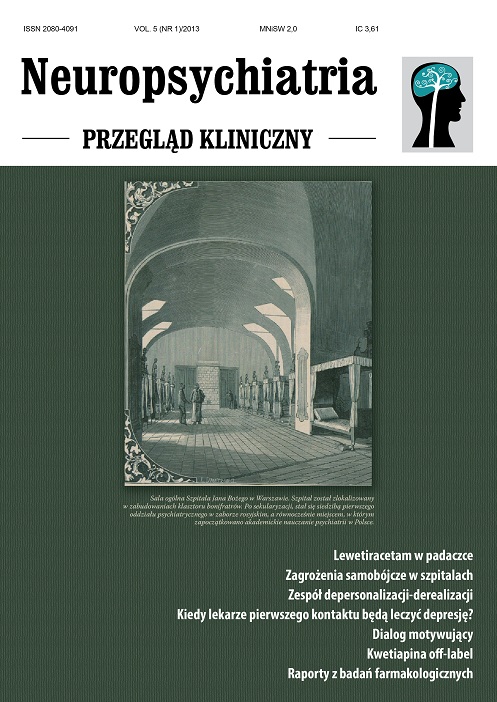When do general practitioners in Poland start to treat depressive disorders? Review article
Main Article Content
Abstract
Worldwide, a broad and marked increase in antidepressant use is occurring, e.g. in older patients or with comorbid somatic illnesses. Patients have become much more accepting of psychiatric medications – a finding that may partially explain this increase. In many countries, the primary care physicians and especially general practitioners are mostly engaged in diagnosing depressive disorders and prescribing antidepressants. 12–15% of patients seen in primary care practices have major depression. There are some advantages and disadvantages of this fact, what is discussed in this article in relation to the Polish situation.
Article Details

This work is licensed under a Creative Commons Attribution-NonCommercial-NoDerivatives 4.0 International License.
Copyright: © Medical Education sp. z o.o. License allowing third parties to copy and redistribute the material in any medium or format and to remix, transform, and build upon the material, provided the original work is properly cited and states its license.
Address reprint requests to: Medical Education, Marcin Kuźma (marcin.kuzma@mededu.pl)
References
2. Cassels C. Antidepressant use on the rise as Americans become more accepting of psychiatric medications. Medscape Medical News 2009.
3. Moore M, Yuen HM, Dunn N, Mullee MA, Maskell J, Kendrick T. Explaining the rise in antidepressant prescribing: a descriptive study using the general practice research database. BMJ 2009; 339: b3999.
4. Healy M. Antidepressants in primary care: is this any way to treat depression? Los Angeles Times 2011 [online: http://articles.latimes.com/2011/aug/04/health/lat-he-depression-treatment-20110804].
5. IMS Institute for Healthcare Informatics. The use of medicines in the United States: Review of 2010. IMS; Parsippany, NJ 2011: 36.
6. Instytut Psychiatrii i Neurologii. Zakłady psychiatrycznej oraz neurologicznej opieki zdrowotnej. Rocznik statystyczny 2009. IPiN; Warszawa 2010: 211.
7. MacArthur Initative on Depression & Primary Care [online: http://www.depression-primarycare.org/].
8. Blount A. Integrated primary care: organizing the evidence. Families, Systems & Health 2003; 21: 121-134.
9. Łoza B. Depresja u osób z zespołem metabolicznym i cukrzycą. W: Mamcarz A.: Zespół metaboliczny. Medical Education; Warszawa 2008, wydanie II, rozdział 44: 529-544.
10. Schimelpfening N. Which doctor is best for treating depression? About.com Depression 2012 [online http://depression.about.com/cs/findadoc/a/bestdoctor.htm].
11. Mosiołek A. Depresja i terapia tianeptyny. Neuropsychiatria. Przegląd Kliniczny 2012; 4(2): 5-10.
12. Starr C. Primary care doctors: treat or refer depressed patients? Medscape 2011 [online: http://www.medscape.com/viewarticle/746112].
13. Kendrick T, King F, Albertella L, Smith PW. GP treatment decisions for patients with depression: an observational study. Br J Gen Pract. 2005; 55(513): 280-286.
14. Łoza B. Jak zmierzyć równocześnie lęk i depresję. Szpitalna Skala Lęku i Depresji. Wiadomości Psychiatryczne 2011; 14(4): 3-7.
15. Nutting PA, Rost K, Dickinson M, Werner JJ, Dickinson P, Smith JL, Gallovic B. Barriers to Initiating Depression Treatment in Primary Care Practice. J Gen Intern Med. 2002; 17(2): 103-111.
16. Robinson WD, Geske JA, Prest LA, Barnacle R. Depression treatment in primary care. JABFM 2005; 18: 79-86.
17. Nimalasuriya K, Compton MT, Guillory VJ, Prevention Practice Committee of the American College of Preventive Medicine. Screening adults for depression in primary care: A position statement of the American College of Preventive Medicine. Family Practice 2009; 58(10): 535-538.

